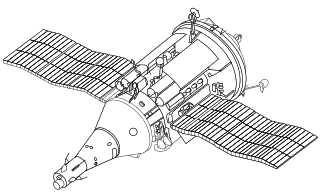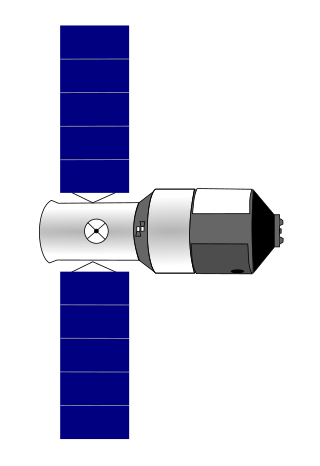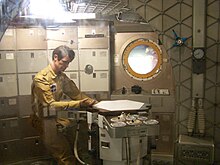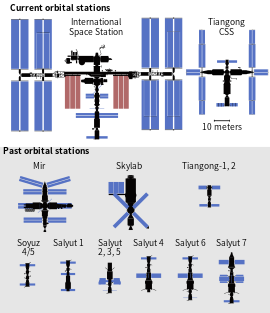
Extravehicular activity (EVA) is any activity done by an astronaut in outer space outside a spacecraft. In the absence of a breathable Earthlike atmosphere, the astronaut is completely reliant on a space suit for environmental support. EVA includes spacewalks and lunar or planetary surface exploration. In a stand-up EVA (SEVA), an astronaut stands through an open hatch but does not fully leave the spacecraft. EVAs have been conducted by the Soviet Union/Russia, the United States, Canada, the European Space Agency and China.

Human spaceflight is spaceflight with a crew or passengers aboard a spacecraft, often with the spacecraft being operated directly by the onboard human crew. Spacecraft can also be remotely operated from ground stations on Earth, or autonomously, without any direct human involvement. People trained for spaceflight are called astronauts, cosmonauts (Russian), or taikonauts (Chinese); and non-professionals are referred to as spaceflight participants or spacefarers.

A space station is a spacecraft capable of supporting a human crew in outer space for an extended period of time and is therefore a type of space habitat. It lacks major propulsion or landing systems. An orbital station or an orbital space station is an artificial satellite. Stations must have docking ports to allow other spacecraft to dock to transfer crew and supplies. The purpose of maintaining an orbital outpost varies depending on the program. Space stations have most often been launched for scientific purposes, but military launches have also occurred.

Mir was a space station that operated in low Earth orbit from 1986 to 2001, operated by the Soviet Union and later by Russia. Mir was the first modular space station and was assembled in orbit from 1986 to 1996. It had a greater mass than any previous spacecraft. At the time it was the largest artificial satellite in orbit, succeeded by the International Space Station (ISS) after Mir's orbit decayed. The station served as a microgravity research laboratory in which crews conducted experiments in biology, human biology, physics, astronomy, meteorology, and spacecraft systems with a goal of developing technologies required for permanent occupation of space.

The Salyut programme was the first space station programme, undertaken by the Soviet Union. It involved a series of four crewed scientific research space stations and two crewed military reconnaissance space stations over a period of 15 years, from 1971 to 1986. Two other Salyut launches failed. In one respect, Salyut had the task of carrying out long-term research into the problems of living in space and a variety of astronomical, biological and Earth-resources experiments, and on the other hand the USSR used this civilian programme as a cover for the highly secretive military Almaz stations, which flew under the Salyut designation. Salyut 1, the first station in the programme, became the world's first crewed space station.
Human spaceflight programs have been conducted, started, or planned by multiple countries and companies. Until the 21st century, human spaceflight programs were sponsored exclusively by governments, through either the military or civilian space agencies. With the launch of the privately funded SpaceShipOne in 2004, a new category of human spaceflight programs – commercial human spaceflight – arrived. By the end of 2022, three countries and one private company (SpaceX) had successfully launched humans to Earth orbit, and two private companies had launched humans on a suborbital trajectory.

The Almaz program was a highly secret Soviet military space station program, begun in the early 1960s.

The TKS spacecraft was a Soviet spacecraft conceived in the late 1960s for resupply flights to the military Almaz space station.

The Shuttle–Mir program was a collaborative 11-mission space program between Russia and the United States that involved American Space Shuttles visiting the Russian space station Mir, Russian cosmonauts flying on the Shuttle, and an American astronaut flying aboard a Soyuz spacecraft to engage in long-duration expeditions aboard Mir.

A space rendezvous is a set of orbital maneuvers during which two spacecraft, one of which is often a space station, arrive at the same orbit and approach to a very close distance. Rendezvous requires a precise match of the orbital velocities and position vectors of the two spacecraft, allowing them to remain at a constant distance through orbital station-keeping. Rendezvous may or may not be followed by docking or berthing, procedures which bring the spacecraft into physical contact and create a link between them.

The Tiangong program is China's space program to create a modular space station, comparable to Mir. This program is independent and unconnected to any other international space-active countries. The program is part of the China Manned Space Program that began in 1992. The core module of the Tiangong space station, the Tianhe was finally launched on 29 April 2021 marking the start of the Tiangong Space program deployment.

The Orlan space suit is a series of semi-rigid one-piece space suit models designed and built by NPP Zvezda. They have been used for spacewalks (EVAs) in the Russian space program, the successor to the Soviet space program, and by space programs of other countries, including NASA.

Mir, DOS-7, was the first module of the Soviet/Russian Mir space station complex, in low Earth orbit from 1986 to 2001. Generally referred to as either the core module or base block, the module was launched on 20 February 1986 on a Proton-K rocket from LC-200/39 at the Baikonur Cosmodrome. The spacecraft was generally similar in design to the two previous Soviet orbital stations, Salyut 6 and Salyut 7, however possessed a revolutionary addition in the form of a multiple docking node at the forward end of the module. This, in addition to the docking port at the rear of the spacecraft, allowed five additional modules to be docked directly to DOS-7, greatly expanding the station's capabilities.

The International Space Station programme is tied together by a complex set of legal, political and financial agreements between the fifteen nations involved in the project, governing ownership of the various components, rights to crewing and utilisation, and responsibilities for crew rotation and resupply of the International Space Station. It was conceived in September 1993 by the United States and Russia after 1980s plans for separate American (Freedom) and Soviet (Mir-2) space stations failed due to budgetary reasons. These agreements tie together the five space agencies and their respective International Space Station programmes and govern how they interact with each other on a daily basis to maintain station operations, from traffic control of spacecraft to and from the station, to utilisation of space and crew time. In March 2010, the International Space Station Program Managers from each of the five partner agencies were presented with Aviation Week's Laureate Award in the Space category, and the ISS programme was awarded the 2009 Collier Trophy.

The Orbital Piloted Assembly and Experiment Complex was a 2009–2017 proposed third-generation Russian modular space station for low Earth orbit. The concept was to use OPSEK to assemble components of crewed interplanetary spacecraft destined for the Moon, Mars, and possibly Saturn. The returning crew could also recover on the station before landing on Earth. Thus, OPSEK could form part of a future network of stations supporting crewed exploration of the Solar System.

Docking and berthing of spacecraft is the joining of two space vehicles. This connection can be temporary, or partially permanent such as for space station modules.

Tianhe, officially the Tianhe core module, is the first module to launch of the Tiangong space station. It was launched into orbit on 29 April 2021, as the first launch of the final phase of Tiangong program, part of the China Manned Space Program.






















